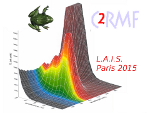Among the multiple applications of Light emitting diodes (LEDs), archaeology and earth sciences have benefited too concerning the determination of time (chronology) based on the optically stimulated luminescence (OSL) method of dating artifacts, material culture of archaeological and geoarchaeological significance. Blue Light emitting diodes (LED) is mostly used for stimulation and bleaching of luminescence, in lieu of green and IR LEDs. Ancient inorganic materials made of geological rocks (carving, knapping, mixing, firing) are either fired in antiquity above 450o C or sun exposed for a short time (surface luminescence dating) and thus the electron traps are completely bleached for the “zero time” clock to set up. The importance of blue LEDs in archaeology was the research product of 2014 Nobel Prize in Physics. On the occasion of blue LED invention and Nobel Prize we offer an extended overview of the development of semiconductor physics focused on LEDs (blue, green, IR) and linked to the principles of OSL dating in archaeology.
The Nobel Prize in Physics 2014 was awarded jointly to Isamu Akasaki, Hiroshi Amano and Shuji Nakamura "for the invention of efficient blue light-emitting diodes which has enabled bright and energy-saving white light sources". When theyproduced bright blue light beams from their semi-conductors in the early 1990s (Akasaki et al 1992, 1993, 2014) they triggered a fundamental transformation of lighting technology. Figure 1 shows the structure of a modern LED. In the inset of the same Figure, the LT-buffer which enabled the growth of the GaN pure crystal is also shown.(Li et al 1993).
Here we give a brief account of the physics of LEDs and link their application as light stimulated sources in the luminescence method of chronology for reconstructing the past human evolution (Liritzis et al, 2013).. We recapitulate in the form of review a) the physics of LEDs, b) the lattice defects in minerals, c) the OSL in archaeology & geosciences, d) a historical development of LEDs in OSL dating. This review is also initiated for the celebration of the current International Year of Light.
- Poster

 PDF version
PDF version

